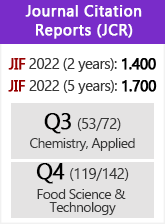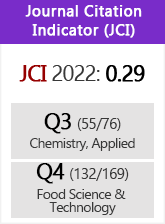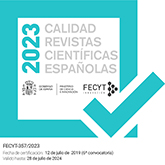Exploring harmony in extra virgin olive oils and vegetables pairings
DOI:
https://doi.org/10.3989/gya.0117191Keywords:
Bitter, Extra virgin olive oil, Food pairing, Green fruity, Radicchio, VegetablesAbstract
Despite the growing interest in the sensory and healthy properties of extra virgin olive oil (EVOO), the topic of oil-food pairing is practically unexplored. This study systematically explores sensory effects on the flavor and harmony obtained by combining two ingredients (EVOOs and vegetables) and aims to provide practical indications for harmonic oil-vegetable combinations. The approach considered an optimal pairing of five EVOOs combined with five typical raw Italian vegetables characterized by different degrees of bitterness (Artichoke, Late Treviso radicchio, Chioggia radicchio, rocket, Early Treviso radicchio). An Index of Disharmony was computed for each pairing, using intensity ratings given by a trained panel that described EVOOs, vegetables and pairings. The results suggested a flavor congruency principle to enhance the oil-pairing harmony. EVOOs with intense green and bitter flavor maximise harmony when combined with very bitter or very pungent vegetables. EVOOs with moderate green flavor and bitterness seemed best paired with vegetables with low/intermediate bitterness.
Downloads
References
Bastian SEP, Collins C, Johnson TE. 2010. Understanding consumer preferences for Shiraz wine and Cheddar cheese pairings. Food Qual. Pref. 21 (7), 668-678. https://doi.org/10.1016/j.foodqual.2010.02.002
Bell L, Methven L, Signore A, Oruna-Concha MJ, Wagstaff C. 2017. Analysis of seven salad rocket (Eruca sativa) accessions: The relationships between sensory attributes and volatile and non-volatile compounds. Food Chem. 218, 181-191. https://doi.org/10.1016/j.foodchem.2016.09.076 PMid:27719896 PMCid:PMC5066371
Bullon S. 1978. Longman Dictionary of the Contemporary English, Longman, Harlow, UK.
Caporale G, Policastro S, Monteleone E. 2004. Bitterness enhancement induced by cut grass odorant (cis-3-hexen- 1-ol) in a model olive oil. Food Qual. Pref. 15 (3), 219-227. https://doi.org/10.1016/S0950-3293(03)00061-2
Cefola M, Carbone V, Minasi P, Pace B. 2016. Phenolic profiles and postharvest quality changes of fresh-cut radicchio (Cichorium intybus L.): nutrient value in fresh vs. stored leaves. J. Food Compos. Anal. 51, 76-84. https://doi.org/10.1016/j.jfca.2016.06.004
Cerretani L, Bendini A, Rotondi A, Mari M, Lercker G, Gallina Toschi T. 2004. Evaluation of the oxidative stability and organoleptic properties of extra-virgin olive oils in relation to olive ripening degree. Prog. Nutr. 6, 50-56.
Cerretani L, Biasini G, Bonoli-Carbognin M, Bendini A. 2007. Harmony of virgin olive oil and food pairing: A methodological proposal. J. Sens. Stud. 22 (4), 403-416. https://doi.org/10.1111/j.1745-459X.2007.00115.x
Commission Regulation (EEC) No 2568/91 of 11 July 1991 on the characteristics of olive oil and olive-residue oil and on the relevant methods of analysis. Official Journal of the European Union, L 248 5.9.1991
Cravotto G, Nano GM, Binello A, Spagliardi P, Seu G. 2005. Chemical and biological modification of cynaropicrin and grosheimin: A structure-bitterness relationship study. J. Sci. Food Agr. 85 (10), 1757-1764. https://doi.org/10.1002/jsfa.2180
Dinnella C, Masi C, Zoboli G, Monteleone E. 2012. Sensory functionality of extra-virgin olive oil in vegetable foods assessed by Temporal Dominance of Sensations and Descriptive Analysis. Food Qual. Pref. 26 (2), 141-150. https://doi.org/10.1016/j.foodqual.2012.04.013
Drewnowski A, Gomez-Carneros C. 2000. Bitter taste, phyonutrients, and the consumer: a review. Am. J. Clin. Nutr. 72 (22), 1424-1435. https://doi.org/10.1093/ajcn/72.6.1424 PMid:11101467
Eschevins A, Giboreau A, Allard T, Dacremont C. 2018. The role of aromatic similarity in food and beverage pairing. Food Qual. Pref. 65, 18-27. https://doi.org/10.1016/j.foodqual.2017.12.005
European Commission , 2013 COMMISSION IMPLEMENTING REGULATION (EU) No 1348/2013 of 16 December 2013 amending Regulation (EEC) No 2568/91 on the characteristics of olive oil and olive-residue oil and on the relevant methods of analysis. Official Journal of the European Union, L 338, 17 December 2013.
Gerhold KA, Bautista DM. 2009. Molecular and cellular mechanisms of trigeminal chemosensation. Ann. NN. Acad. Sci. 1170, 184-189. https://doi.org/10.1111/j.1749-6632.2009.03895.x PMid:19686135 PMCid:PMC2879328
Gutiérrez-Rosales F, Ríos JJ, Gómez-Rey ML. 2003. Main polyphenols in the bitter taste of virgin olive oil. Structural confirmation by on-line high-performance liquid chromatography electrospray ionization mass spectrometry. J. Agric. Food Chem. 51 (20), 6021-6025. https://doi.org/10.1021/jf021199x PMid:13129311
International Olive Council (IOC). 2007. Glass for oil tasting. COI/T.20/DOC. 5/REV.1 - 2007.
Keller KL, Steinmann L, Nurse RJ, Tepper BJ. 2002. Genetic taste sensitivity to 6-n-propylthiouracil influences food preference and reported intake in preschool children. Appetite 38 (1), 3-12. https://doi.org/10.1006/appe.2001.0441 PMid:11883912
Kostyra E, Baryłko-Pikielna N, Dabrowska U. 2010. Relationship of pungency and leading flavour attributes in model food matrices - temporal aspects. Food Qual. Pref. 21 (2), 197-206. https://doi.org/10.1016/j.foodqual.2009.03.007
Lawless HT. 2000. Sensory combinations in the meal, in: Meiselman, H.D. (Ed.), Dimensions of the Meal: the Science, Culture, Business and Art of Eating, Aspen Publishers, Gaithersburg, MD, 92-106.
Lawless HT, Heymann H. 1999. Sensory evaluation of food: principles and practice. Springer, New York. https://doi.org/10.1007/978-1-4615-7843-7 PMCid:PMC1723178
Naes T, Brockhoff B, Tomic O. 2010. Quality control of sensory profile data. In: Statistics for sensory and consumer science. J. Wiley & Sons, Chichester, UK, pp.11-38. https://doi.org/10.1002/9780470669181.ch3
Pasini F, Verardo V, Cerretani L, Caboni MF, D'Antuono LF. 2011. Rocket salad (Diplotaxis and Eruca spp.) sensory analysis and relation with glucosinolate and phenolic content. J. Sci. Food Agr. 91 (15), 2858-2864. https://doi.org/10.1002/jsfa.4535 PMid:21725983
Paulsen MT, Rognså GH, Hersleth M. 2015. Consumer perception of food-beverage pairings: The influence of unity in variety and balance. Int. J. Gast. Food Sci. 2, 83-92. https://doi.org/10.1016/j.ijgfs.2014.12.003
Procida G, Giomo A, Cichelli A, Conte LS. 2005. Study of volatile compounds of defective virgin olive oils and sensory evaluation: A chemometric approach. J. Sci. Food Agr. 85 (13), 2175-2183. https://doi.org/10.1002/jsfa.2122
Procida G, Cichelli A, Lagazio C, Conte L. 2016. Relationships between volatile compounds and sensory characteristics in virgin olive oil by analytical and chemometric approaches. J. Sci. Food Agr. 96 (1), 311-318. https://doi.org/10.1002/jsfa.7096 PMid:25597626
Ranalli A, Lucera L, Contento S, Simone N, Del Re P. 2004. Bioactive constituents, flavors and aromas of virgin oils obtained by processing olives with a natural enzyme extract. Eur. J. Lipid Sci. Technol. 106, 187-197. https://doi.org/10.1002/ejlt.200300863
Recchia A, Monteleone E, Tuorila H. 2012. Responses to extra virgin olive oils in consumers with varying commitment to oils. Food Qual. Pref. 24 (1), 53-161. https://doi.org/10.1016/j.foodqual.2011.10.009
Rotondi A, Bertazza G. 2001. Caratteri chimici dell'olio di oliva. In: La qualità dell'olio extravergine di oliva dei colli riminesi: la cultivar Correggiolo. Cristoferi, G. Ed. La Mandragora, Bologna, Italy, 87-99 [Rotondi A, Bertazza G. 2001. Chemical characteristics of olive oil. In: The quality of extra virgin olive oils from the Rimini hills: the Corregiolo variety. Edited by Cristoferi, G. La Mandragora, Bologna, Italy, pp. 87-99]
Spinelli S. 2014. Investigating the culinary use of olive oils. In: Olive Oil Sensory Science. Eds: Monteleone E, Langstaff S.. Wiley Blackwell, Jhon Wiley & Sons, Ldt, Chichester, UK, pp. 195-225. https://doi.org/10.1002/9781118332511.ch8
Van Duyn MAS, Pivonka E. 2000. Overview of the Health Benefits of Fruit and Vegetable Consumption for the Dietetics Professional Selected Literature. J. Am. Diet. Assoc. 100 (12), 1511-1521 https://doi.org/10.1016/S0002-8223(00)00420-X
Published
How to Cite
Issue
Section
License
Copyright (c) 2020 Consejo Superior de Investigaciones Científicas (CSIC)

This work is licensed under a Creative Commons Attribution 4.0 International License.
© CSIC. Manuscripts published in both the printed and online versions of this Journal are the property of Consejo Superior de Investigaciones Científicas, and quoting this source is a requirement for any partial or full reproduction.All contents of this electronic edition, except where otherwise noted, are distributed under a “Creative Commons Attribution 4.0 International” (CC BY 4.0) License. You may read here the basic information and the legal text of the license. The indication of the CC BY 4.0 License must be expressly stated in this way when necessary.
Self-archiving in repositories, personal webpages or similar, of any version other than the published by the Editor, is not allowed.
















